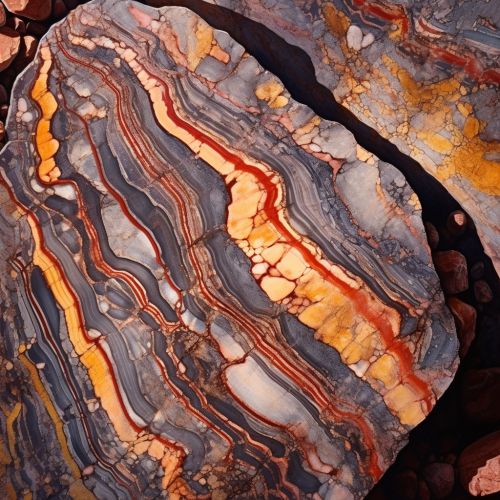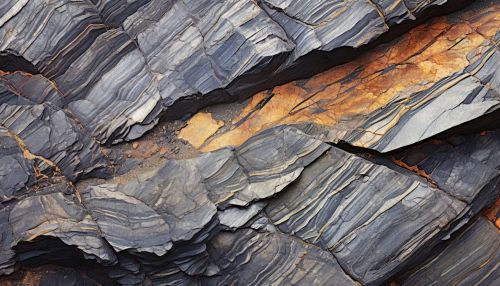Metamorphic rock
Introduction
Metamorphic rocks are one of the three main types of rocks, alongside igneous and sedimentary rocks. They are formed under the Earth's surface through the process of metamorphism, which involves the transformation of existing rock types due to high pressure, high temperature, or both. This process results in a physical or chemical change in the pre-existing rock, known as the protolith.


Formation
Metamorphic rocks are formed from the transformation of existing rock types through the process of metamorphism. This process involves the exposure of the protolith to conditions much different than those in which it initially formed. The protolith may be an igneous, sedimentary, or an older metamorphic rock.
The process of metamorphism occurs within the Earth's crust and upper mantle, under conditions of high pressure, high temperature, or both. These conditions alter the mineralogy, texture, and chemical composition of the rock, resulting in the formation of metamorphic rocks. The changes that occur during metamorphism are always in the solid state, meaning that the rock does not melt during this process. If melting occurs, the rock would become an igneous rock instead.
Types of Metamorphism
There are two main types of metamorphism: regional and contact metamorphism.
Regional Metamorphism
Regional metamorphism occurs over large areas and is associated with large-scale tectonic activity such as mountain building. The protolith is subjected to high pressures and temperatures over a large area, resulting in the formation of metamorphic rocks. This type of metamorphism often results in the formation of foliated rocks, such as gneiss, schist, and slate.
Contact Metamorphism
Contact metamorphism occurs when the protolith is in contact with an igneous intrusion, such as a magma chamber, sill, or dyke. The high temperatures associated with the magma cause the surrounding rock to metamorphose. This type of metamorphism often results in the formation of non-foliated rocks such as marble and quartzite.
Classification
Metamorphic rocks are classified based on their mineral composition and texture. The two main types of textures found in metamorphic rocks are foliated and non-foliated.
Foliated Metamorphic Rocks
Foliated metamorphic rocks are characterized by the alignment of minerals into thin layers or bands. This alignment is caused by the intense pressure that the rock is subjected to during metamorphism. Examples of foliated metamorphic rocks include slate, schist, and gneiss.
Non-Foliated Metamorphic Rocks
Non-foliated metamorphic rocks do not exhibit any alignment of mineral grains. This is usually because the rock was not subjected to differential pressure during metamorphism. Examples of non-foliated metamorphic rocks include marble and quartzite.
Metamorphic Grade
The metamorphic grade of a rock refers to the intensity of metamorphism that the rock has undergone. This is determined by the pressure and temperature conditions that the rock was subjected to during metamorphism. The metamorphic grade is often reflected in the mineral composition of the rock.
Low-grade metamorphic rocks have been subjected to relatively low pressures and temperatures. They often contain minerals such as chlorite, serpentine, and talc. Examples of low-grade metamorphic rocks include slate and phyllite.
High-grade metamorphic rocks have been subjected to high pressures and temperatures. They often contain minerals such as garnet, staurolite, and sillimanite. Examples of high-grade metamorphic rocks include schist and gneiss.
Economic Importance
Metamorphic rocks have various economic uses. Slate, for example, is used in roofing and flooring. Marble, a metamorphosed limestone, is widely used in the construction industry and in sculpture. Garnet, a mineral commonly found in metamorphic rocks, is used as an abrasive.
